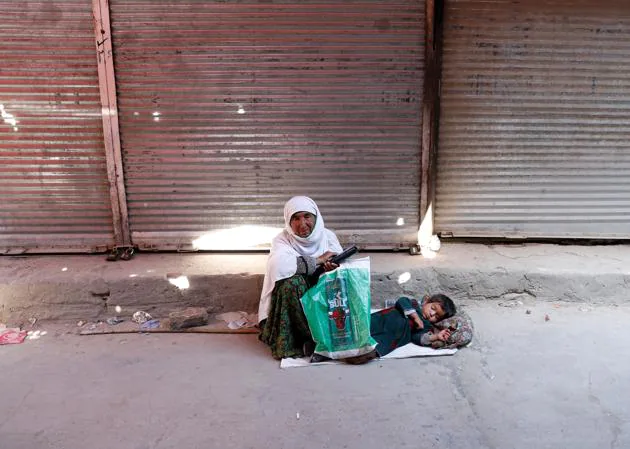Before Covid-19, women with disabilities were already undergoing their own lockdown, invisible and shut out from the rest of the world. Now, the walls are closing in.

An Afghan woman with a child waits for alms in front of closed shops during the coronavirus disease (COVID-19) outbreak in Kabul, Afghanistan April 23, 2020. REUTERS/Mohammad Ismail(REUTERS)
As a girl of 15, Nidhi Goyal wanted to be a portrait artist. Then she became visually-challenged, and turned to activism. “I was 16,” she says about losing sight to a rare genetic condition called retinitis pigmentosa. “It was a struggle and I was slipping into depression until I looked at my own privilege.” She then decided to “do something about it”.
Now 34, the Mumbai-based founder and director of Rising Flame, a non-profit committed to changing the lives of people, especially women and girls with disabilities, finds herself on the UN Women executive director’s civil society advisory group and president of the Association of Women’s Rights in Development.
Before the coronavirus disease (Covid-19) upended the world, women with disabilities were undergoing their own lockdown, invisible and shut out from the rest of the world. Now, the walls are closing in.
“Women with disability have been fighting to get out of their houses as their families worry about letting them navigate alone,” says Goyal. “Now, we are under lockdown again.”
Many of the problems are not unique to women, but apply to all people with disabilities. In some cases, caregivers are not able to reach those who depend on them. Access to medicine and groceries is difficult. Therapy and rehabilitation are on hold. And how do you even begin to practise social distancing if you need help to wash your hands?
But Covid-19 has also reinforced what many people with disabilities believe: They are invisible to society. When policymakers talk about vulnerable people, they refer to older populations and those with underlying conditions like diabetes. People with disabilities have not always specifically been included as vulnerable. “When there’s a crisis, who do we forget? Those we always forget,” says Goyal.
This exclusion is evident also in the global discussion on a spike in domestic violence during the lockdown. But how many women with disabilities face violence at home? Nobody knows. How do you reach them? No one has a clue.
According to the International Disability Alliance, one in five women lives with some form of disability, with an inordinate proportion in developing countries among low-income groups. These women face layers of prejudice that stem from gender, poverty, a lack of education and social prejudice. Often denied sexual and reproductive rights, they are at greater risk of sexual assault and violence.
To counter some of this sense of despair and isolation, Rising Flame has, through every Saturday in April, organised “house parties” (Vella Panti). These have included, a book reading session, movies and podcasts. “It was important for us to remind the community they are not alone,” says Goyal.
The fear, once Covid-19 is behind us, is that the “new normal” might for disabled women end up being the old normal where they struggle to be heard. “I’m concerned that marginalised groups that have always been left out will be excluded again,” says Goyal. “It’s time we took matters in our hand.”
Namita Bhandare writes on gender
The views expressed are personal